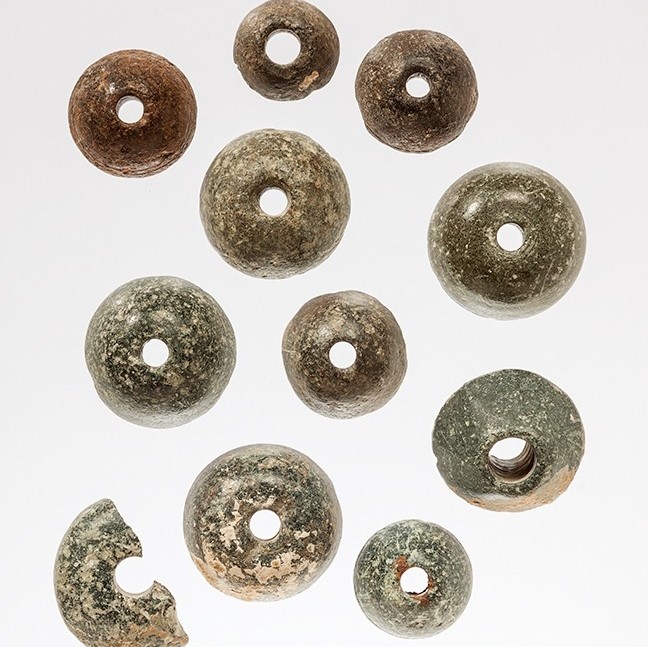
Artefact or object:
Description:
Spinning
Introduction by J.R. Green
The following 12 spindle-whorls (2001.05 and 2002.01-2002.11) are from Jebel Khalid, the Hellenistic Greek settlement overlooking the Euphrates in northern Syria. The site has been excavated since 1986 under the direction of Professor Graeme Clarke of the ANU who has presented these examples to the Museum on indefinite loan from the Syrian Department of Antiquities. There are reports on the site and its finds by G. Clarke et al., Jebel Khalid on the Euphrates: Report on Excavations 1986-1996, i (MeditArch Suppl. 5, Sydney 2002) [abbreviated below as Jebel Khalid i] and H. Jackson, Jebel Khalid on the Euphrates, ii. The Terracotta Figurines (MeditArch Suppl. 6, 2006) as well as regular progress reports in Mediterranean Archaeology.
The chapter by L. Crewe, “Spindle-Whorls and Loomweights” in Jebel Khalid i, 217-243, publishes eleven of these spindle-whorls and provides an excellent introductory section on the form and function of the objects. Note also the general overview by L. Mårtensson, M.-L. Nosch and E. Andersson Strand, “Shape of Things: Understanding A Loom Weight”, Oxford Journal of Archaeology 28, 2009, 373-398. For a somewhat idiosyncratic but interesting cross-cultural discussion, see R.K. Liu, “Spindle Whorls: Pt. I. Some Comments and Speculations”, The Bead Journal 3, 1978, 87-103. And from a technological perspective, J.H. Boertien, “A Simulation Experiment in the Context of a Technological Study of Levantine Iron Age Clay Loom Weights”, Leiden Journal of Pottery Studies 25, 2009, 31-45. There is a good and useful article by C. Sofianou, “Loomweights; Use and Manufacture at Trypitos, Siteia”, Hesperia Suppl. 44: ΣТΕГА: The Archaeology of Houses and Households in Ancient Crete (2011) 421-430, in which she discusses some well-excavated groups of loomweights from a domestic context at this Hellenistic site.
For a series from South Italy, see M. Kleibrink, Excavations at Francavilla Marittima 1991-2004: Finds related to Textiled Production from the Timpone della Motta, vol. 5: Spindle Whorls (BAR Int. Series 2806, Oxford 2016).
As Crewe points out, the central perforations of a number of these whorls diminish in size towards the bottom, so that they would fit more exactly on the wooden spindle. This was not, of course, a necessary sophistication, and it was doubtless coincidental when the fit was totally precise.
The excavation inventory number is given following the Museum number.
See also L. Mårtensson, M.-L. Nosch and E. Andersson Strand, “Shape of Things: Understanding a Loom Weight”, Oxford Journal of Archaeology 28.4, 2009, 373-398.